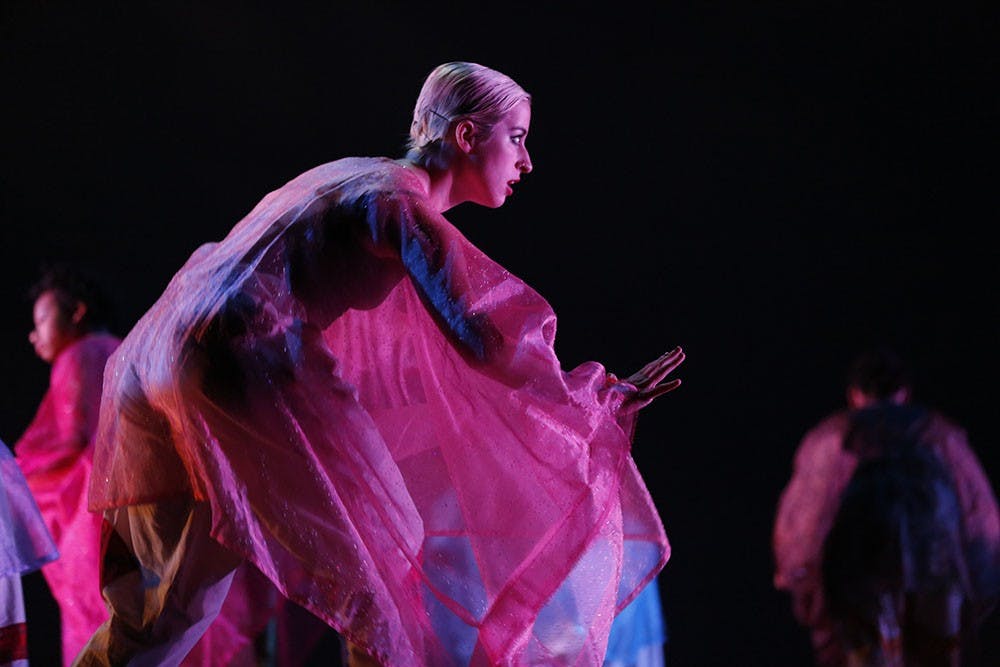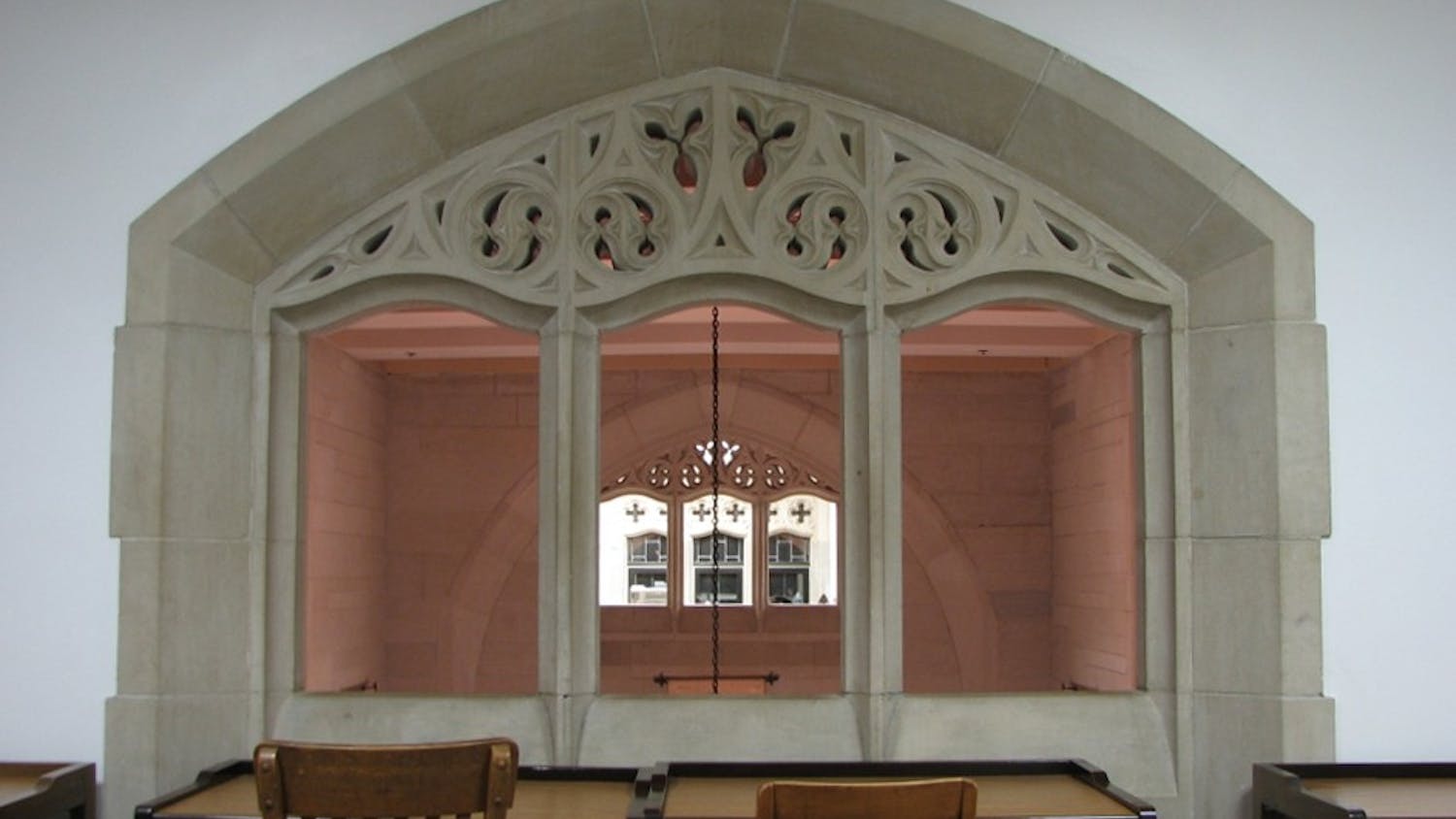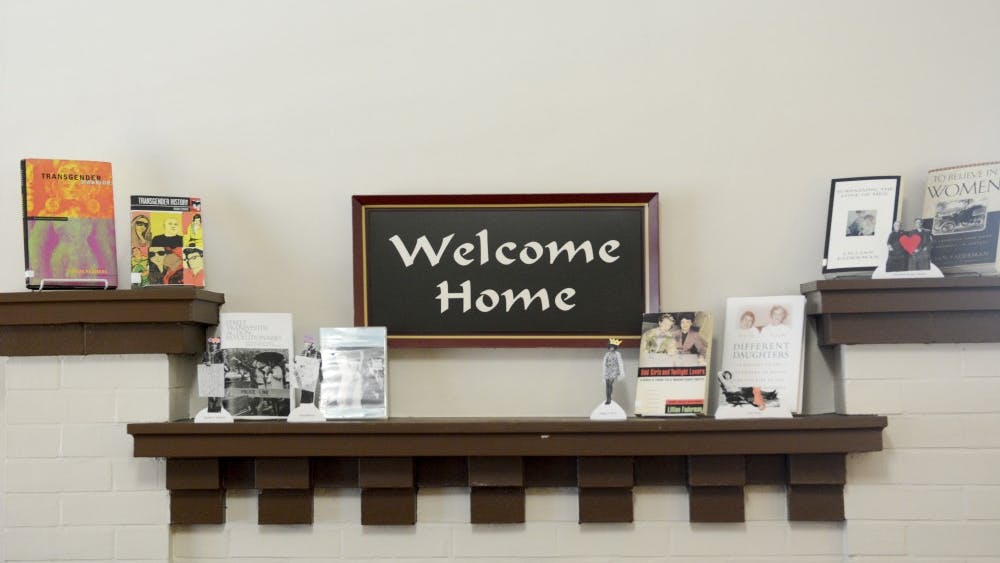Down the hall racquet balls snap against the walls, shouts of triumph and grunts of frustration echo, but in court No. 3, Ode to Joy barrels out of an iPhone speaker.
“You’re going to use your head as an initiation point,” Savannah Serban instructed from the far wall. “Then twist around.”
Charlotte Twitchell spun on one foot and wound her body like a cinnamon twist, whirly arms rotated around her. The once white bottoms of her socks were black from cleaning up dirt as she moved across the racquetball court.
“If that’s weird, don’t do it,” Savannah said.
“No I think I kind of get what you want,” Charlotte said. “Like a meltdown.”
To an untutored eye, the dancers were standing in a white-walled room leaping and twisting and – oh my, should bodies bend like that? The translation from the song to Savannah’s choreographic vision to Charlotte’s exhibition is just the beginning of what will hopefully be a statement, an art and a dance.
Charlotte is a solo dancer in Savannah’s senior independent project, an idea to combine technology and contemporary dance. The goal is for Charlotte to dance with her own shadow on a screen by the end of the project. “With the music?” Savannah asked.
Charlotte breathed deeply and squared her hands on her hips, an orchestra poured out of the speaker and she leapt into the dance.
•••
For most college students, senior year is a checklist of items in preparation for graduation. For the seniors in IU’s department of contemporary dance, the stakes are higher and the competition is rigid. While art classes are continually cut from schools across the nation and trips to the theater are less common, seniors in the contemporary dance program wrestle with finding meaning and a future.
Charlotte was surrounded by seafoam green walls in a dance studio when she announced to everyone, and mostly herself, that she loved dance.
“I love dance,” she simply stated.
The class was a few exercises into their warm up, and the instructor looked at Charlotte.
“Good.”
After years of dance at the Erie Dance Conservatory in Pennsylvania, an audition and consequent wait listing from IU, Charlotte was in limbo. The letter came while she was Economics, and her mom texted the news. Accepted.
Four years later Charlotte is in limbo again. She is getting a Pilates certification and a massage therapy certification, two things she hopes they’ll provide some income while she dances.
She has plans to the end of July: teaching at home and an intensive study in Maine, but the dream is in Europe. Not starving and doing what she loves are also part of the vision, and like many dancers, achieving those goals means money spent and a job on the side.
“The reality is that a professional dancer does not have the income that an doctor or someone has,” Shea said. “Often our students have to get very creative in earning a living and we have to help them do that.” The seniors take a course called senior selection that helps determine what they’ll peruse after graduation. Most students will go on to do a combination of teaching, choreographing and performing. Others go on to physical or occupational therapy.
“We even have a dancing librarian,” Shea laughed. “You’re prepared to do many, many things with dancing.”
•••
No other major runs from its history like contemporary dance. At least that’s what Shea likes to say, and her programs history was a glitch in design.
Originally IU had one dance program in the physical education part of the College of Arts and Sciences. It began in 1927 and was called modern dance. Decades later, when Jacobs needed ballerinas for their operas, a second track of dance formed and the programs split in two. Today the contemporary dance department is part of the Theater, Drama, and Contemporary Dance in the College of Arts and Sciences and is the second oldest in the nation.
But what is contemporary dance? Images of gyrating hips and sweaty grinding come to mind. That’s the dancing they do in rap videos, right?
“Modern dance is a concert dance form like ballet; it is meant for the stage,” Shea said. “But it is also an experimental art form.”
A large part of the program is reinventing the traditional perception of dance. One composition class last semester performed a dance in the Jordan River. A few senior students each year spend six weeks preparing a dance for a two-hour session.
Savannah’s senior project falls into the category of reinvention. Another senior just broke her foot and is working on performing an entire solo from a chair.
•••
Everyday dancers stare into mirrors that magnify and leotards that accentuate fat deposits and imperfections.
Shortly after puberty, Charlotte filled out a once stick-like figure. She would never be a ballerina. She’d been told to diet and try cardio, but the genetics weren’t there.
The long and lean inheritances required didn’t match her thighs and butt.
“You want to be defined, muscular and lean so you can fit into the lines and shapes and look aesthetically pleasing,” Charlotte said. “It’s a weird balance because on one hand it is your art, but there’s also the mental health aspect. Are you crossing borders?”
Body and style is just a slice of the fight. A degree in the arts isn’t always a practical or stable route.
Shea said she grappled in college; trying to justify something she enjoyed so much. Why does dance matter?
Sometimes the answer is as simple as a microphone to hard topics like politics, sexual abuse and war. But most often dance plays at the heart of the human experience.
“Art matters.” Shea says the words with conviction. All around her desk and scattered across the walls are silhouettes bending and twisting. In their photos the dancers are frozen like paintings, suspended for a moment in art.
“Weather it is popular or abstract, art is the essence of human expression,” she says, “People that are dancers – that is their artistic medium.”
Charlotte always had the support of a devoted, Italian family, Sunday dinners and all. Her grandfather financed piano and violin lessons and her grandmother was the encouraging keystone. Proud family and small successes make every grueling rehearsal or bleak tomorrow a triumph.
“Some days I literally hate dance, but I would never leave it,” she said. “Ultimately the hate is fueled by the love. Sometimes all it takes is two second to remember, I get one triple turn in class and it’s all worth it.”
•••
Black scuffmarks line the bottoms of the walls in the racquetball court, a dull, florescent light flickers and faint odor lingers from a previous game. The small court in the School of Public Health is hardly a stage for art and expression.
Charlotte sits on the floor, legs spread, fanning a bright red face. The Charlotte’s Web shirt she is wearing is spackled with dots of sweat, and a few escapee hairs curl out of a smatter of bobbie pins.
“I want to do something a little more boom.” Savannah says.
Charlotte stands, runs across the floor and throws herself into a grand jeté, a long, horizontal jump starting on one leg and landing on the other.
“Yes, I like that,” Savannah clapped.
Charlotte the did the routine again, a minute and a half marathon of defying gravity and finding balance.
“What do you think?” Savannah asked. “I think that’s enough for the day.”
“Yeah,” Charlotte said. “For today.”






